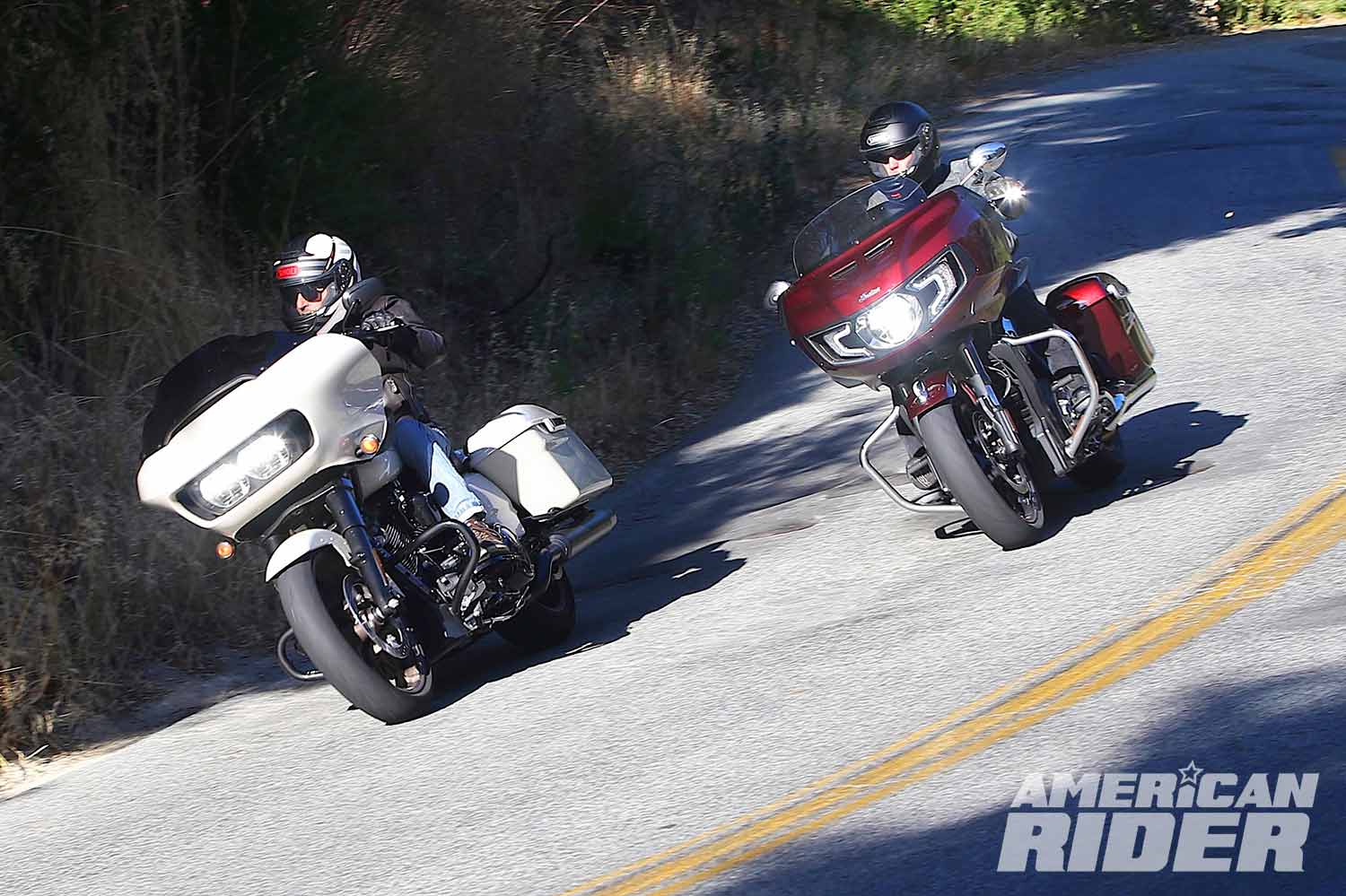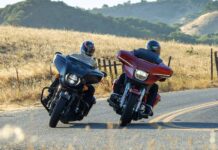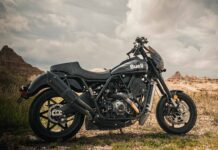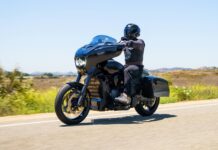Photos by Bill McMillan
Baggers offer up an enviable balance of style and versatility that can’t be ignored. The class is led by the potent one‑two punch of Harley‑Davidson Road Glide and Street Glide models, the bestselling large‑displacement motorcycles in America.
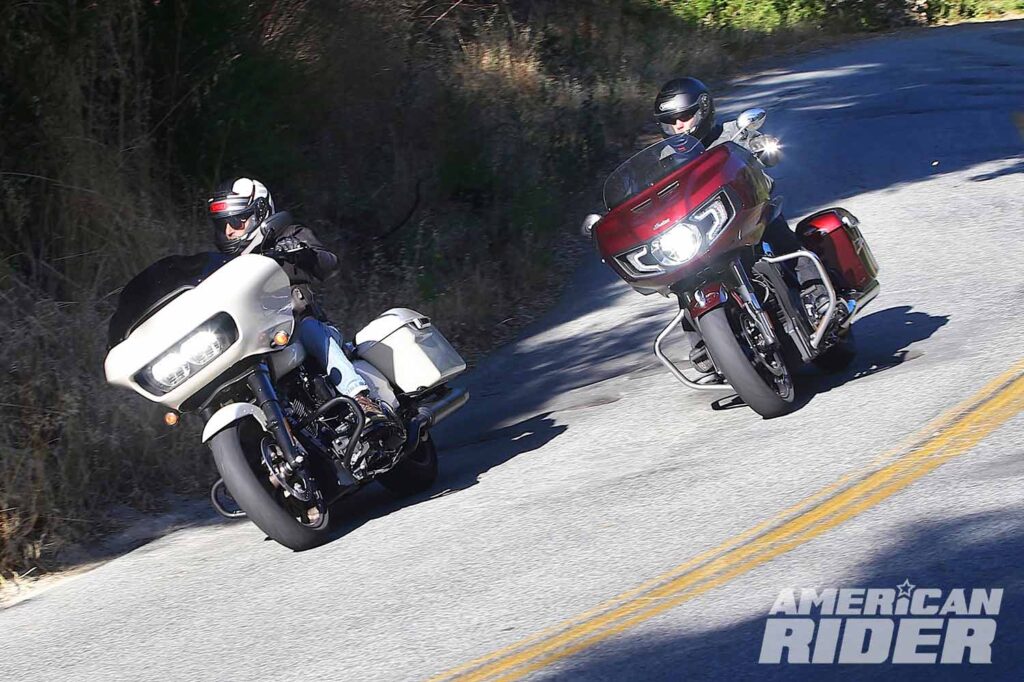
When it comes to the Street Glide with its bar-mounted fairing, it is naturally matched up with Indian’s Chieftain. For this comparo, we pitted the Road Glide against Indian’s liquid-cooled Challenger in a duel of baggers with frame-mounted fairings.
There could be no better destination for this shootout than California’s Monterey Peninsula where MotoAmerica’s King Of The Baggers series would race at the famed Laguna Seca racetrack. Nowhere else is the battle among baggers more incendiary, so we decided to use the stock baggers as intended and take a road trip to observe the thunderous on-track KOTB action while doing a comparison test.
The Formula
The recipes for building an American bagger with a frame‑mounted fairing share many ingredients. The bikes tested here use powerful rumbling V‑Twins routing big‑time torque through 6‑speed transmissions with belt final drives. The duo also share long footboards that allow a variety of leg positions, low seat heights, and top-loading lockable saddlebags augmented with a pair of fairing pockets.
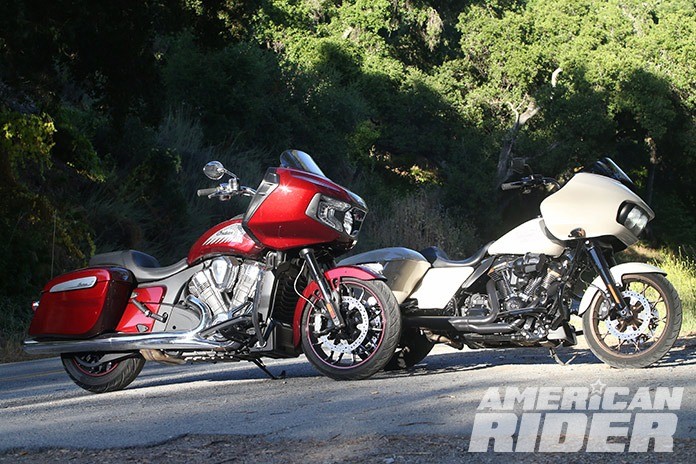
Riders sit behind fixed fairings that don’t perturb the steering like fork-mounted fairings and are fitted with LED headlights and adjustable vents. Both have keyless ignition, cruise control, and touchscreen infotainment systems with audio, navigation, Bluetooth, and USB ports.
These bikes weigh about 850 lb with their 6-gallon fuel tanks full, easily enabling more than 200 miles between gas stops, and they command similar prices. The formula can be tweaked by selecting model and trim choices that offer a variety of paint and finish options or incorporate electronic rider aids like cornering ABS and traction control, as well as different levels of audio systems.
Old School: The Road Glide
There’s nothing in motorcycling quite as iconic as the Road Glide’s sharknose fairing, which has been silhouetted across America since the arrival of the FLT Tour Glide in 1979 for the 1980 model year. The FLTR Road Glide officially debuted in 1998.
Our trip brought an unusual element. Harley loaned us a Harley-Davidson Road Glide ST for the ride up to Monterey, but we needed to swap it for a 2022 Harley-Davidson Road Glide Special for the trip back home. It gave us two chances at an RG experience.
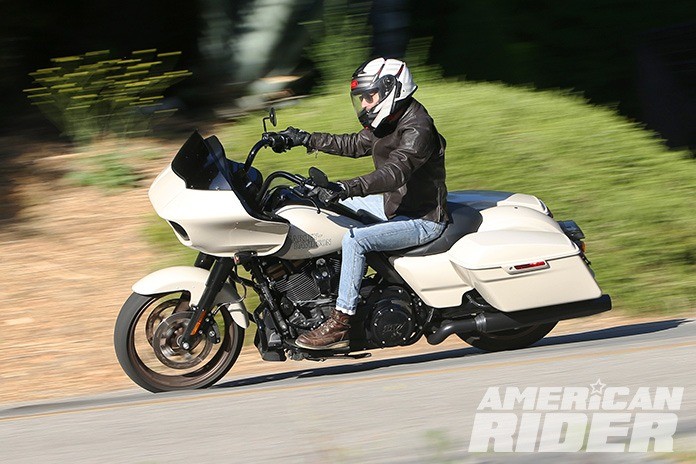
GEAR UP
- Helmet: Shoei Neotec 2
- Jacket: Alpinestars Hoxton V2
- Gloves: Alpinestars GPX V2
- Pants: SA1NT Unbreakable
- Boots: H-D Hagerman
The base version of the Harley-Davidson Road Glide is priced at just $21,999, but it uses the 107ci M-8 engine. The 2023 Road Glide Special includes the 114ci motor and starts at $27,999; a color option with chrome finishes like our test bike adds $750. The ST retails for $29,999, not including the White Sand Pearl colorway on our ST, which adds $750 to its MSRP. Both RGs in this comparo were equipped with H-D’s Reflex Defensive Rider System, a $1,100 option that includes an inertial measurement unit (IMU) for traction control and cornering ABS.
Related: 2023 Harley-Davidson CVO Glides Review | First Ride
With apologies to the Indian Challenger, the Harley-Davidson Road Glide is a more attractive machine. Its sharknose fairing is not only iconic, it’s also prettier than the Indian’s blockier wind protection. And there’s no denying the visual appeal of the Harley’s uncluttered air-cooled V-Twin when compared to liquid-cooled motors with requisite radiators.

The RG-ST’s 117ci Milwaukee-Eight is a beastly peach, strongly pulling from 2,000 rpm until petering out near its 5,500 rpm redline. The Special’s 114ci mill satisfies, but not as deeply as the ST’s potent bigger Twin. The difference in power is noticeable, with the MoCo claiming 118 lb-ft at 3,250 rpm vs. 127 lb-ft at 3,750 rpm, respectively.
New School: The Challenger
Indian’s Challenger is aptly named, as it adopts the RG’s bagger formula and updates it with a liquid-cooled V-Twin that out-muscles anything in Harley’s air-cooled lineup.
Pricing for Challengers begins at $24,999, which includes features like a 7-inch touchscreen panel, ride modes, traction control, ABS, and an electrically adjustable windshield. We tested the upmarket Limited version, which has a $28,499 base MSRP and includes a passel of upgrades: chrome finishes, color-matched fender closeouts, remote-locking saddlebags, contrast-cut wheels with machined edges, an illuminated headdress on the front fender, and IMU-based Smart Lean technology for cornering ABS and traction control. Add $750 for the rich Maroon Metallic paint on our test bike, and you’re up to $29,249.
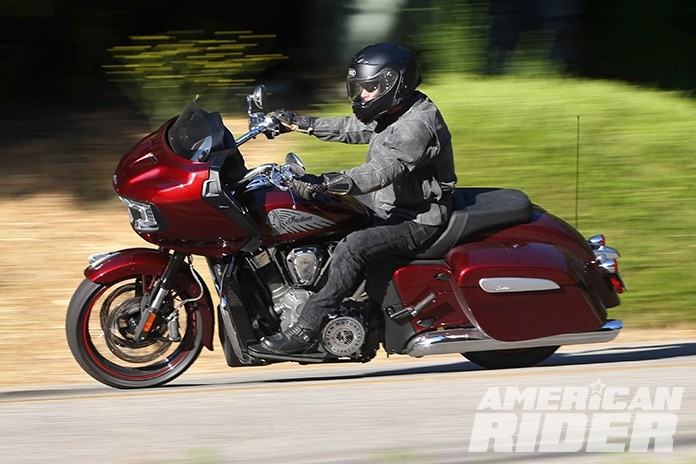
GEAR UP
- Helmet: Shoei Neotec
- Jacket: Highway 21 Gunner
- Gloves: Held
- Pants: Alpinestars Copper 2
- Boots: TCX X-Ride Waterproof
The Challenger’s PowerPlus 108 engine name refers to its cubic-inch displacement (1,768cc in metric terms), and Indian says it produces 128 lb-ft of torque and 122 hp at its crankshaft. Its 4 valves per cylinder are actuated by SOHCs, enabling a rev limit of 6,500 rpm – 1,000 rpm higher than the Harley’s. In a previous test, Harley’s 114ci engine produced 79 hp at its rear wheel, while the PowerPlus cranked out 108 ponies.
Related: Indian Challenger RR – 2022 King Of The Baggers Race Replica
Indian did a nice job dressing up the liquid-cooled motor with vestigial cylinder fins and chrome accents, as well as hiding the radiator within the front aluminum frame spars, but it just ain’t as pretty as the MoCo’s air-cooled motor. Similarly, the Challenger’s overall appearance doesn’t look quite as debonair as its venerable rival, with a blockier and less refined look.
But refinement comes in other forms, and the Challenger has key advantages that endow it with a more modern cockpit, greater all-weather versatility, and a more comfortable ride.
The Ride
Since these are baggers, packing luggage for the weekend was easy. Bonus points go to the Challenger for having slightly larger bags and to the Limited version for having remotely locking ones that enhance their usability. The RGs win a point back for their deeper storage compartments in their fairing cubbies.
Getting to Laguna necessitated pounding out miles from our SoCal digs to the Monterey Peninsula, cutting through freeway traffic before setting cruise control at 80 mph and settling in for the highway slog.
Both M-8s in the Road Glides are incredibly smooth at speed, with negligible vibes filtering to riders. It’s only at idle when they shake in their rubber mounts. More disturbing is the harshness of impacts from bumps in the road, especially over sharper-edged ones and notably felt at the rear end. The shocks on the Harley-Davidson Road Glide Special have just 2 inches of travel, while the ST’s have 3 inches.
The Challenger comes to the party with 4.5 inches of bump-erasing rear travel, which delivers a dramatically smoother ride over all road imperfections. Its inverted fork also boasts more travel than the Harleys, with 5.1 inches of stroke to the Glides’ 4.6 inches. Added up, the Challenger has a decisive advantage in ride comfort from the suspension, and engine counterbalancers quell objectionable vibration.
Pilot’s Cabin
When cruising along the superslab, you have plenty of time to observe the layout and functionality of the cockpits. The RG’s 6.5-inch TFT panel located up high is the only nod to modernity, flanked by an analog fuel gauge and voltmeter and the speakers for the audio system. Its analog speedo and tach are located inconveniently low and just ahead of the handlebar mounts, and the small gear-position indicator is nearly impossible to see at a glance. We look forward to when the OE Road Glides are updated with the cockpit of the new CVO version tested here.

We prefer the layout of the Challenger’s cockpit, which places the analog speedo and tach near the base of the windshield, making them easier to read. The Indian’s adjustable front-brake lever would seem an obvious feature to have on a $30K bagger, but the RGs don’t have one.
Seating comfort is comparable and largely dependent on the roads you’re rolling over – the Challenger’s seat feels plusher when encountering repeated bumps. A passenger will prefer the Indian’s seat more than the rearward-sloping perch of the Road Glide Special. Passengers on the RG-ST will need to sit on its fender.
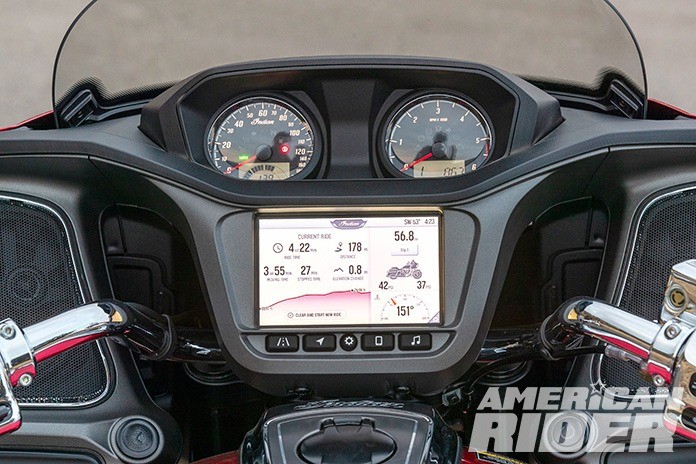
The Indian’s gauges are augmented by a 7-inch touchscreen panel that’s customizable for a variety of menus and displays that can be controlled by touch, menu buttons below the screen, or via handlebar controls. The Ride Command infotainment system includes a 100-watt audio system, navigation, and ride modes.
I’d like to provide a definite evaluation of the audio systems, but neither offers clear aural satisfaction above 65 mph, and we didn’t bother using them much around town. If it’s any consolation, the 6.5-inch speakers in the Challenger are 1 inch larger than the RG’s Boom Box GTS system, and Indian gets a bonus point for cheekily marking max volume at 11. (“Well, it’s one louder, isn’t it?” remarked Nigel Tufnel in This Is Spinal Tap.)
Unable to get audio satisfaction at our highway speed, we wondered how much cheaper and lighter a bagger could be by ditching the heavy speakers (and their amplifiers) and instead simply relying on clearer audio streamed to headsets. I’d guess at least $1,000 and 20 lb, maybe more. And if you could choose to lop off two dozen pounds from any motorcycle, there would be no better place than the high-mounted location of these speakers.

While air management is quite good on the Harley-Davidson Road Glide, it can’t beat the adaptability of the Indian Challenger’s electrically adjustable windscreen. Although its 3-inch range doesn’t seem like much, the difference between up and down is dramatic. Leave it in the low position around town or when it’s hot outside for a similar experience as on the Harley-Davidson Road Glide, or extend it whenever desired at the touch of a button. In its uppermost position, wind noise is reduced to the point that earplugs aren’t necessary at highway speeds. The adjustability is a huge benefit for a bike intended for touring.
Getting Twisty
A trip to Monterey always includes the magnificent Pacific Coast Highway – er, almost always. Sadly, PCH through Big Sur has been closed for reconstruction since early in the year, so one of the best roads in the world was off limits.
After devouring miles of U.S. Route 101, we headed west to ride the sinuous Carmel Valley Road. We did our best imitations of KOTB champs Kyle Wyman and Tyler O’Hara to delve into the handling capabilities of the street versions of the bikes they ride.
King Of The Baggers Corkscrew Clash At Laguna Seca
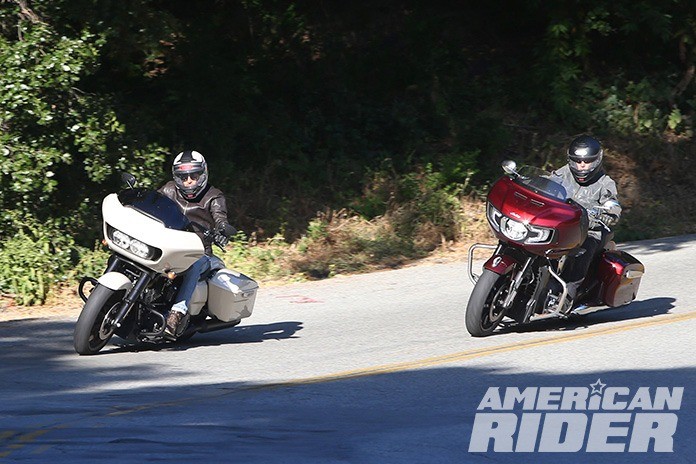
Truth be told, there’s not much difference when their 130/60-B19 front tires are levered into corners. These baggers handle remarkably well for bikes of their size, and neither exhibited quirky responses.
The Indian’s advantage lies in its suspension travel, able to suck up bumpy pavement while leaned over that can unsettle or ground-out the RGs. Sparking footboards arrives around 31 degrees – it’s difficult to conceive the 55-degree lean angles regularly exceeded by Wyman and O’Hara. The RG Special drags its sidestand earlier than its ST brother.
Differences are slight. We appreciated the straighter handlebar bend of the Challenger over the pull-backs on the RG, the former allowing a sportier crouch when unwinding corner after corner. The Indian also has an edge in shift quality, which operated more cleanly than the Harley’s clunkier gearbox.
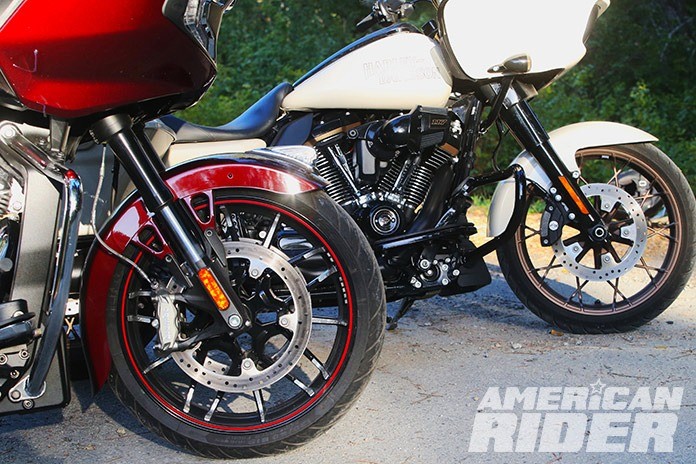
A small edge goes to the Indian’s Brembo braking system, which delivered marginally better responses up front through radial-mount calipers and 320mm discs than the axial-mount Brembos and 300mm rotors on the RGs. And we didn’t like the Harleys’ rear brake pedal that’s located inconveniently high – whether crawling through city traffic or stabbing at when trying to help slow the bike before tight corners through Carmel Valley.
The power advantage of the Indian’s motor is nice to have, but seldom was it able to be put to good use. H-D’s M-8s do their job well, tractoring smartly out of corners, especially the 117 motor in the ST. That said, we all love having more power even if we don’t often use it, and the PowerPlus indeed has more. It pulls strongly from low rpm, and its higher rev limit can negate a shift when the Harley demands one.
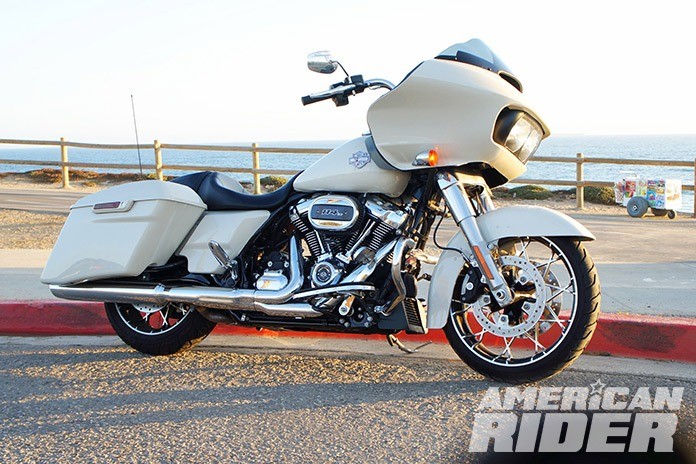
Bagging A Winner
It’s easy to understand the popularity of baggers. This duo ably took on a 750-mile trip that included twisty roads and boring straight ones, and they were even fun to rip around town and for sunset beach cruises.
“Baggers lull me into a vehicular Zen mode – physically and metaphorically slowing me down enough to enjoy the very essence of motorcycling,” commented seasoned motojournalist and co-rider in this comparo, Eric Putter. “These bikes basically accelerate, turn, stop, and go about their business in a very similar manner.”
So, should we call it a draw?
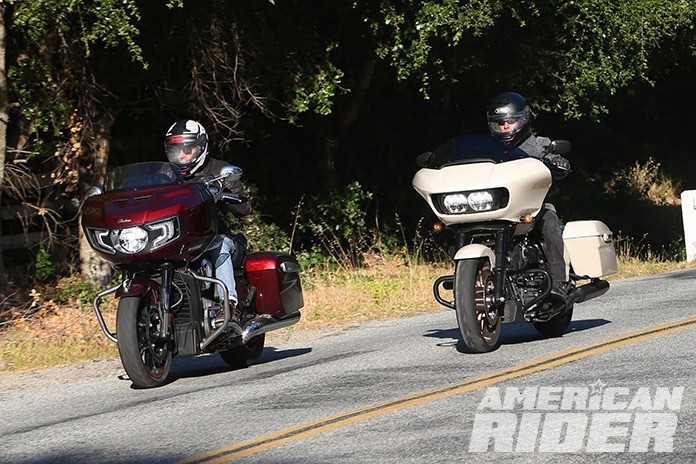
No, that would be unfair to the affable Challenger, which is much better at insulating riders from the harshness of rough roads, a serious consideration for riders who want to hammer out miles in comfort. It would be disingenuous to describe the Road Glides as plush when ridden on bumpy roads.
Also notable for a road-trippin’ machine is the benefit of the Challenger’s adjustable windscreen for adapting to various weather conditions. Its value was determined by its frequent use during testing, providing a highly practical element that’s unavailable from Harley.
“For me,” Putter summed up, “the Indian wins because it’s a more modern, better-sorted motorcycle.”
If you use your bagger for stylin’ on the way to a local hangout or one that’s a short trip away, it’s nearly impossible to top the alluring profile of the Road Glide and one of its air-cooled Milwaukee-Eight motors. But if you want a bagger to chase distant horizons, we’d choose the more comfortable, more powerful, and more adaptable Challenger.
And if I had to build a bagger racebike, doing the job cheaply and by my limited-skills mechanical self, I’d start with a Challenger. Its more powerful motor would help me gain time on straightaways that my limited-skills racer self would inevitably lose in the corners. The only time I’d get to a 55-degree lean angle is midway into a crash.


